

10 Common Myths About Evolution – PALEONTOLOGY WORLD. Evolution is the single most important concept in all of biology.

It is absolutely vital for understanding both the history of life on earth and why our modern organisms have their current traits and behaviors. Nevertheless, it is also one of the most misunderstood concepts in modern science. Much of the confusion stems from creationists’ faulty arguments, but even those who accept evolution often don’t really understand it. Therefore, I am going to describe and debunk ten of the most common myths and misconceptions about evolution. Myth 1: Evolution is just a theory This is arguably the most common myth about evolution, and it is probably creationists’ most well worn trope. Finally, it is worth noting that theories are actually among our highest forms of scientific certainty.
It's a Bird … It's a Plane … It's a Superhero Mantis Shrimp! They have the world’s most perceptive color vision and can see light that few other creatures in the animal kingdom can.

They send invisible messages. They hold a bevy of biological world records and might be called the Deadpool of the oceanic universe. Researchers imprint stable, chemically active polymer equivalents of DNA. In a carefully designed polymer, researchers at the Polish Academy of Sciences have imprinted a sequence of a single strand of DNA.

The resulting negative remained chemically active and was capable of binding the appropriate nucleobases of a genetic code. The polymer matrix—the first of its type—thus functioned exactly like a sequence of real DNA. Imprinting of chemical molecules in a polymer, or molecular imprinting, is a method that has been under development for many years. However, it has never before been used to construct a polymer chain complementing a sequence of a single strand of DNA. The researchers in Warsaw collaborated with colleagues at the University of North Texas (UNT) in Denton and the University of Milan in Italy. Typically, molecular imprinting is accomplished in several steps. Why can't monkeys talk like us? Their vocal tract might not be the problem.
A talking monkey seems like a thing of science-fiction, cartoons, and goofy advertisements.
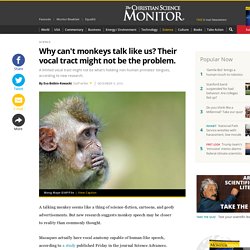
But new research suggests monkey speech may be closer to reality than commonly thought. Macaques actually have vocal anatomy capable of human-like speech, according to a study published Friday in the journal Science Advances. "This suggests that what makes people unique among primates is our ability to control the vocal apparatus, not the apparatus itself," Thore Jon Bergman, an evolutionary biopsychologist at the University of Michigan who was not part of the research, writes in an email to The Christian Science Monitor. Researchers studying non-human primates had previously hypothesized that the shape, size, or structure of the vocal anatomy in the animals' heads might be holding them back from making the sorts of sounds that make up human speech. To test this idea, scientists decided to look at the vocal anatomy itself. DNA-editing breakthrough could fix 'broken genes' in the brain, delay ageing and cure incurable diseases. Scientists have discovered a new way to edit DNA that could fix “broken genes” in the brain, cure previously incurable diseases and potentially even extend the human lifespan.

The breakthrough – described as a “holy grail” of genetics – was used to partially restore the sight of rats blinded by a condition which also affects humans. Previously researchers were not able to make changes to DNA in eye, brain, heart and liver tissues. But the new technique allows them to do this for the first time and could also lead to new treatments for a range of diseases associated with the ageing process. Researchers Restored A Colony Of Microbes In The Gut. Last month, Popular Science discussed the state of gut microbiome research and the often overgeneralized claims of many probiotics.
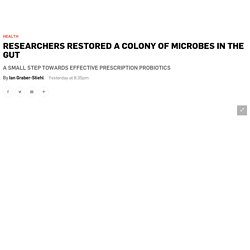
As we concluded, the field is still in its infancy and one of the main challenges to creating effective prescription probiotics is that it’s extremely difficult to culture a lasting population of specific bacteria in the gut. But in a paper out last week in the journal Cell Host and Microbe, researchers at the University of Alberta showed that they were able to culture a strain of bacteria in the gut for at least six months.
This success, while small, may help to bring us one step closer to creating effective prescription probiotics. Researchers produce healthy mice without using fertilized eggs. Dolphins recorded having a conversation 'just like two people' for first time. Frogs from hell: Their venomous head spikes could kill you. In the wilds of Brazil, researchers have discovered frogs with venomous spikes on their heads.
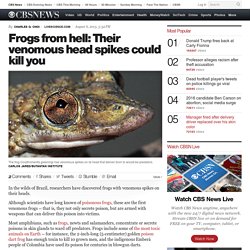
Although scientists have long known of poisonous frogs, these are the first venomous frogs -- that is, they not only secrete poison, but are armed with weapons that can deliver this poison into victims. Most amphibians, such as frogs, newts and salamanders, concentrate or secrete poisons in skin glands to ward off predators. Frogs include some of the most toxic animals on Earth -- for instance, the 2-inch-long (5-centimeter) golden poison dart frog has enough toxin to kill 10 grown men, and the indigenous Emberá people of Colombia have used its poison for centuries in blowgun darts.
Now scientists have discovered -- the hard way -- two species of Brazilian frog that are venomous. One researcher, study lead author Carlos Jared at the Butantan Institute in São Paulo, injured his hand on bony spines on the head of the frog Corythomantis greeningi, which lives in savannas in eastern Brazil. ChronicGastroInflammationInducesAnxiety-LikeBehavior-Bercik.pdf. Researchers discover first sensor of Earth's magnetic field in an animal.
A team of scientists and engineers at The University of Texas at Austin has identified the first sensor of the Earth's magnetic field in an animal, finding in the brain of a tiny worm a big clue to a long-held mystery about how animals' internal compasses work.
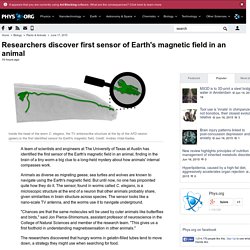
Animals as diverse as migrating geese, sea turtles and wolves are known to navigate using the Earth's magnetic field. But until now, no one has pinpointed quite how they do it. The sensor, found in worms called C. elegans, is a microscopic structure at the end of a neuron that other animals probably share, given similarities in brain structure across species. The sensor looks like a nano-scale TV antenna, and the worms use it to navigate underground. Scientists discover a second genetic code – except not really.
It’s hard to imagine a more sensational biology headline than that: a second genetic code.
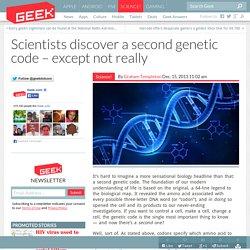
The foundation of our modern understanding of life is based on the original, a 64-line legend to the biological map. It revealed the amino acid associated with every possible three-letter DNA word (or “codon”), and in doing so opened the cell and its products to our never-ending investigations. If you want to control a cell, make a cell, change a cell, the genetic code is the single most important thing to know — and now there’s a second one?
Well, sort of. Scientists Make Female Fish That Produce Working Sperm. Knocking out just a single gene in Japanese rice fish makes otherwise female fish produce sperm.
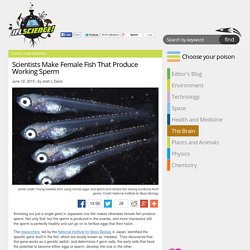
Not only that, but the sperm is produced in the ovaries, and more impressive still, the sperm is perfectly healthy and can go on to fertilize eggs that then hatch. The researchers, led by the National Institute for Basic Biology in Japan, identified the specific gene foxl3 in the fish, which are locally known as ‘medaka’. They discovered that this gene works as a genetic switch, and determines if germ cells, the early cells that have the potential to become either eggs or sperm, develop into one or the other. “While germ cells can become either sperm or eggs, nobody knew that in vertebrates the germ cells have a switch mechanism to decide their own sperm or egg fate,” explained Professor Minoru Tanaka, co-author of the study published in Science. Scientists just found soft tissue inside a dinosaur fossil. Here's why that's so exciting. Dinosaur fossils, it was long thought, are simple objects.
The fossilization process leaves the overall shape of a dinosaur's bones intact, but all the microscopic structures inside them — the blood cells, connective fibers, and other sorts of soft tissue — inevitably decay over time. But that view is changing — and it's possible that many ancient fossils may preserve more detail than meets the eye. Giant pandas cannot properly digest bamboo, scientists find.
"The animals also do not have the genes for plant-digesting enzymes in their own genome. A guide to CRISPR, the human gene-editing tool that has scientists excited — and terrified. We are now one step closer to designer babies. Using a technique called CRISPR, geneticists in China recently modified the DNA of nonviable human embryos and published the results in the journal Protein & Cell. Editing the genetic material of human embryos was a first — and the April 18 publication of the results set off a cascade of awe and controversy.
"While these embryos will not be growing up into genetically modified people," science journalist Carl Zimmer wrote in National Geographic, "I suspect this week will go down as a pivotal moment in the history of medicine. " Untitled. Affiliations Institute of Neuroscience, Newcastle University, Newcastle upon Tyne NE2 4HH, UK Sébastien C. Kessler, Kerry L. Simcock, Samantha Softley & Geraldine A. Wright Botany Department, Trinity College Dublin, Dublin 2, Ireland Erin Jo Tiedeken & Jane C. New mass extinction event identified by geologists - BBC News. Over the past 450 million years, life on Earth has been devastated by five mass extinction events that are widely recognised by geologists. Now, an international team of researchers proposes adding a sixth mass extinction to the list. The team believes it has accumulated sufficient evidence to promote the Capitanian event to the rank of mass extinction.
The extinction occurred approximately 262 million years ago. Their proposal would elevate the Capitanian, which occurred during the Middle Permian period, to sit alongside the so-called "Big Five" mass extinctions. This Worm Creates A New Self Inside Its Existing Self. Male bonding lowers stress levels and is more relaxing than evening with the wife. With 2000+ global studies affirming safety, GM foods among most analyzed subjects in science. No, GMOs Won't Harm Your Health. 5_Alessi_Mark.pdf. The spectral transmission of ocular media suggests ultraviolet sensitivity is widespread among mammals.
Abstract Although ultraviolet (UV) sensitivity is widespread among animals it is considered rare in mammals, being restricted to the few species that have a visual pigment maximally sensitive (λmax) below 400 nm. IVF first: Baby born with embryo selection from DNA screening. An in vitro fertilization (IVF) milestone has been announced by British researchers. For the first time, a baby was born using a new embryo screening technique combs through genetic data looking for risk for diseases and other abnormalities. Scientists Discover New Kind Of Sexual Organ. Harvard researchers unravel evolution of genitalia - Science. Patrick Tschopp/Harvard Medical School. Scientists reverse ageing process in mice; early human trials showing 'promising results'
Updated Scientists from Harvard and the University of New South Wales say they have discovered how to reverse the ageing process. The research has focused on mice, but early clinical trials have also been conducted on humans. The scientists said they switched youthful genes on and older genes off, using naturally occurring proteins and molecules. Algae Virus May Be Changing Cognitive Ability. Plants Know They Are Being Eaten. Vegetarians and vegans pay heed, new research shows plants know when they’re being eaten. And they don’t like it. That plants possess an intelligence is not new knowledge, but according to Modern Farmer, a new study from the University of Missouri shows plants can sense when they are being eaten and send out defense mechanisms to try and stop it from happening.
Mushroom-shaped deep-sea animal Dendrogramma baffles scientists. Scientists found the new mushroom-shaped animal, called Dendrogramma, while analyzing organisms collected at ocean depths of 400 and 1000 metres on the south-east Australian continental slope. ( Just et al. Cold, Dark and Alive! Life Discovered in Buried Antarctic Lake. Dogs' Floppy Ears Are a Symptom of 'Domestication Syndrome' Plants Talk. Plants Listen. Here's How : Krulwich Wonders... Could this "immortal" jellyfish unlock the secret to human life extension? Let There Be Life: Researchers Created Brand New Kind of Working DNA.
Scientists Add Letters to DNA’s Alphabet, Raising Hope and Fear. A, T, C, G, X and Y: An New Organism with Unnatural DNA. Study finds unexpected link between cell suicide and longevity. This Leech Can Survive A 24-Hour Submersion in Liquid Nitrogen. World ancestry. Cold? Good thing if you want to lose weight, researchers say. There is a class of animals that never grow old. 50,000 generations of bacteria prove that evolution never stops. Orgasm for dummies: Neuroscience explains why sex feels good. Woman with ‘Syndrome X’ dies at 20 but still looks like a toddler. Scientists Discover New Biological Clock With Age-Measuring Potential. Fear memories can be overcome during sleep, researchers say. Evolutionary biologists resolve 'Darwin's dilemma' Scientists create new memories by directly altering neurons in the brain.
Insect uses 'gears' to jump, study finds. Super-Rat Roamed Earth 160 Million Years Ago. Researchers find scientific basis for near-death experiences. Monogamy and Human Evolution. Evolution: Fossils Pinpoint Ape and Monkey Split. Early hominins couldn't have heard modern speech - life - 13 May 2013. Tiny Winged Fossil Reveals Origins of Speedy Swift and Hummingbird Flight : Nature & Environment. New technique gives see-through view into mouse brains.
Scientists unravel mysteries of spider silk to create bulletproof vests, artificial tendons. Learning to love cereal was key to the evolution of dogs. Epigenetics: Neurons remember because they move genes in space. Honey, It's Electric: Bees Sense Charge On Flowers. Identical Mutations in Seperate Populations Over 1,000 Generations.
Test Tube DNA Brain Gets Quiz Questions Right. Common Ancestor of Mammals Plucked From Obscurity. First-Ever Incredible Footage of a Thought Being Formed. Zoologger: The first solar-powered vertebrate - life - 18 January 2013. Scientific evidence that you probably don’t have free will. The Brazilian Treehopper may be the strangest creature we've ever laid eyes on. Evolutionary trick of bizarre insect headgear revealed - Image 1. Protein in Semen Acts on Brain and Triggers Ovulation : biology : NatureWorldNews. Simple reaction makes the building blocks of a nucleic acid. Scientists create artificial memory in brain tissue, in vitro for the first time - National health.
NASA Discovers Unprecedented Blooms Of Ocean Plant Life. Modern Birds Are Really Baby Dinosaurs. Sex-starved fruit flies turn to alcohol, researchers find. Amazing Microscopic Video Footage of a T Cell Attacking a Cancer Cell - Kasia Cieplak-Mayr von Baldegg - Video. In a scalding spring, one species of microbe is becoming two. 32,000-year-old Arctic flower: Ancient remains used to grow plant not seen in millennia. Quick learner: Viruses find new ways of infecting us - The Times of India. Scientists Create First Monkeys With Mixed Genomes. Implanted neurons, grown in the lab, take charge of brain circuitry.
How to Make a Transparent Mouse Embryo Using Pee. DNA building blocks found in meteorites. Plants evolve special leaves to make sounds that bats enjoy. Northerners' brains are bigger, scientists find. b1tKA.jpg (JPEG Image, 800x2603 pixels) New Self-Cloning Lizard Found in Vietnam Restaurant. How the Inbred Lab Mouse Helps Reprogram the Human Genome. Human cell becomes living laser. Gut Bacteria Divide People Into 3 Types, Scientists Report. New species of dinosaur bridges gap in dinosaur family tree. BBC - Earth News - Plant lives inside animal: algae invade amphibian cells. Molecular Visualizations of DNA. NASA Finds New Life (Updated) The Biodesign Institute at Arizona State University. BBC - Earth News - Attack of the rats.
Mass Animal Deaths. One gene lost = one limb regained? Scientists demonstrate mammalian regeneration through a single gene deletion. The Tuatara, a Still-Evolving Original.